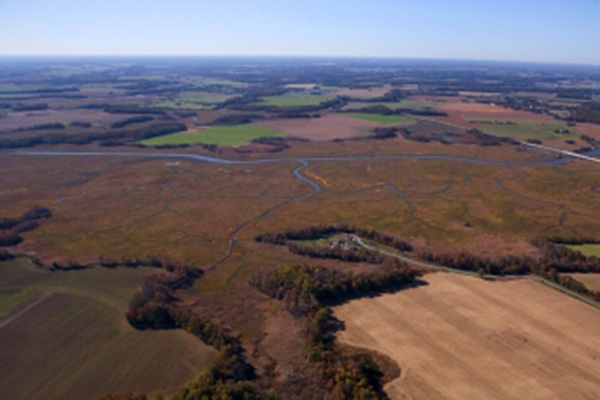
April 12: DENIN field trip
Join DENIN, partners in guided trip to St. Jones Reserve in Kent County
11:34 a.m., March 22, 2013--The Delaware Environmental Institute (DENIN) at the University of Delaware, Delaware Wild Lands, the state’s oldest land conservation organization, and the Delaware National Estuarine Research Reserve are sponsoring a free field trip to the St. Jones Reserve, in Kent County, Del., on Friday, April 12.
A component of the Delaware National Estuarine Research Reserve (DNERR), the St. Jones Reserve includes about 3,750 acres of tidal brackish-water and salt marshes, wooded fringe habitat, farmlands and meadows distributed along the lower St. Jones River. The St. Jones watershed drains a portion of central Kent County, including the city of Dover, and empties into Delaware Bay.
Events Stories
June 5: Blue Hen 5K
June 6-9: Food and culture series
The DNERR and Delaware Wild Lands played a pivotal role in protecting and restoring the unique natural and cultural resources of the area.
“The St. Jones River and its watershed serve as a microcosm of the many cultural, historical and environmental factors that have and will continue to shape Delaware and the Mid-Atlantic region,” says Kate Hackett, executive director of Delaware Wild Lands. “This tour is designed to highlight and help connect us, geographically and through time, to the dynamic changes occurring in our environment. By understanding our coastal heritage and the historic uses of the river and its watershed, then considering them in the context of issues like sea level rise and climate change, we will be better positioned to address the challenges we face now and into the future.”
Participants in the field trip will learn about the natural, human and ecological systems affected by the St. Jones River and what factors are impacting the river, including patterns of historic use and climate change. The group will travel in vans from the headwaters to the mouth of the river, meeting experts at several locations in the field to view special resources along the river, discuss impacts to the river and discover how the watershed is being enhanced and restored.
Participants will meet at 12:30 p.m. on April 12, rain or shine, at the St. Jones Reserve, 818 Kitts Hummock Road, Dover, Del. (directions), and return to the reserve headquarters at about 4:30 p.m. The trip is limited to 20 participants, so reservations are required. To make a reservation, contact Delaware Wild Lands at 302-378-2736 or info@dewildlands.org by Monday, April 8.
This event is part of the “Challenges and Choices” series of events being hosted by DENIN in 2013 to focus attention on four major environmental challenges facing Delaware: sea level rise and extreme weather events, food and water security, land use and energy.
About the St. Jones Reserve
The St. Jones Reserve features tidal brackish-water and salt marshes dominated by saltmarsh cordgrass (Spartina alterniflora), salt hay (Spartina patens) and open water of creek, river and bay areas, buffered by freshwater wooded fringe, farmlands and meadows. This low-lying area is a prime example of habitat that is threatened by rising sea levels expected to occur over the next century.
The St. Jones River watershed drains a portion of the coastal plain in central Kent County, Del., including the city of Dover, the surrounding suburbs, industrial areas, agricultural areas and Dover Air Force Base. The upper St. Jones is impounded by a dam 10.5 miles upstream from the bay to form Silver Lake, a municipal recreation area. Some other headwater streams are also impounded. Much of the eastern portion (bayward) of the watershed consists of wetlands and forests, including lands and waters managed for waterfowl, wild turkey, deer and other wildlife.
Article by Beth Chajes
Photo courtesy of Eric Crossan/DNREC








